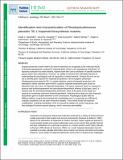Identification and characterization of Rhodopseudomonas palustris TIE-1 hopanoid biosynthesis mutants
Author(s)
Doughty, David M.; Wu, C.-H.; Newman, Dianne K.; Welander, Paula V.; Mehay, S.; Summons, Roger E; ... Show more Show less
DownloadSummons_Identification and.pdf (3.774Mb)
OPEN_ACCESS_POLICY
Open Access Policy
Creative Commons Attribution-Noncommercial-Share Alike
Terms of use
Metadata
Show full item recordAbstract
Hopanes preserved in both modern and ancient sediments are recognized as the molecular fossils of bacteriohopanepolyols, pentacyclic hopanoid lipids. Based on the phylogenetic distribution of hopanoid production by extant bacteria, hopanes have been used as indicators of specific bacterial groups and/or their metabolisms. However, our ability to interpret them ultimately depends on understanding the physiological roles of hopanoids in modern bacteria. Toward this end, we set out to identify genes required for hopanoid biosynthesis in the anoxygenic phototroph Rhodopseudomonas palustris TIE-1 to enable selective control of hopanoid production. We attempted to delete 17 genes within a putative hopanoid biosynthetic gene cluster to determine their role, if any, in hopanoid biosynthesis. Two genes, hpnH and hpnG, are required to produce both bacteriohopanetetrol and aminobacteriohopanetriol, whereas a third gene, hpnO, is required only for aminobacteriohopanetriol production. None of the genes in this cluster are required to exclusively synthesize bacteriohopanetetrol, indicating that at least one other hopanoid biosynthesis gene is located elsewhere on the chromosome. Physiological studies with the different deletion mutants demonstrated that unmethylated and C[subscript 30] hopanoids are sufficient to maintain cytoplasmic but not outer membrane integrity. These results imply that hopanoid modifications, including methylation of the A-ring and the addition of a polar head group, may have biologic functions beyond playing a role in membrane permeability.
Date issued
2012-01Department
Massachusetts Institute of Technology. Department of Earth, Atmospheric, and Planetary SciencesJournal
Geobiology
Publisher
Wiley Blackwell
Citation
Welander, P. V., D. M. Doughty, C.-H. Wu, S. Mehay, R. E. Summons, and D. K. Newman. “Identification and Characterization of Rhodopseudomonas Palustris TIE-1 Hopanoid Biosynthesis Mutants.” Geobiology 10, no. 2 (March 2012): 163–177.
Version: Author's final manuscript
ISSN
14724677
1472-4669